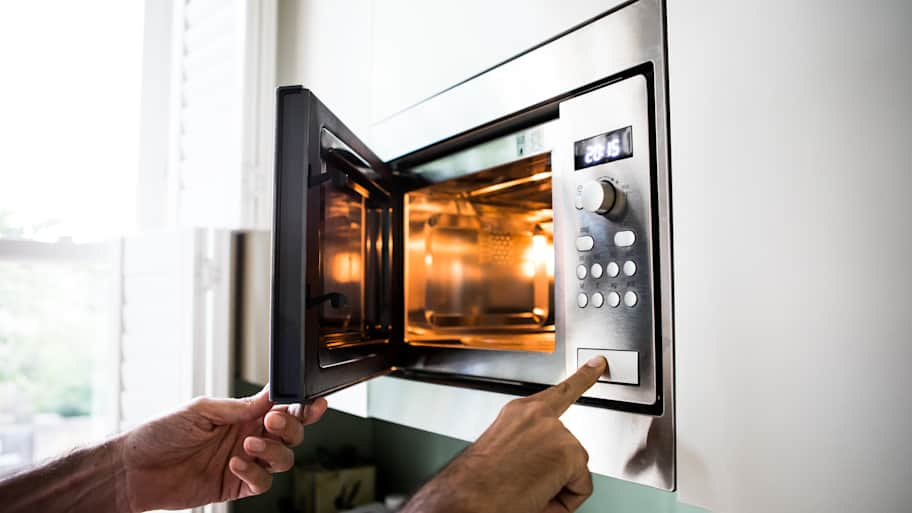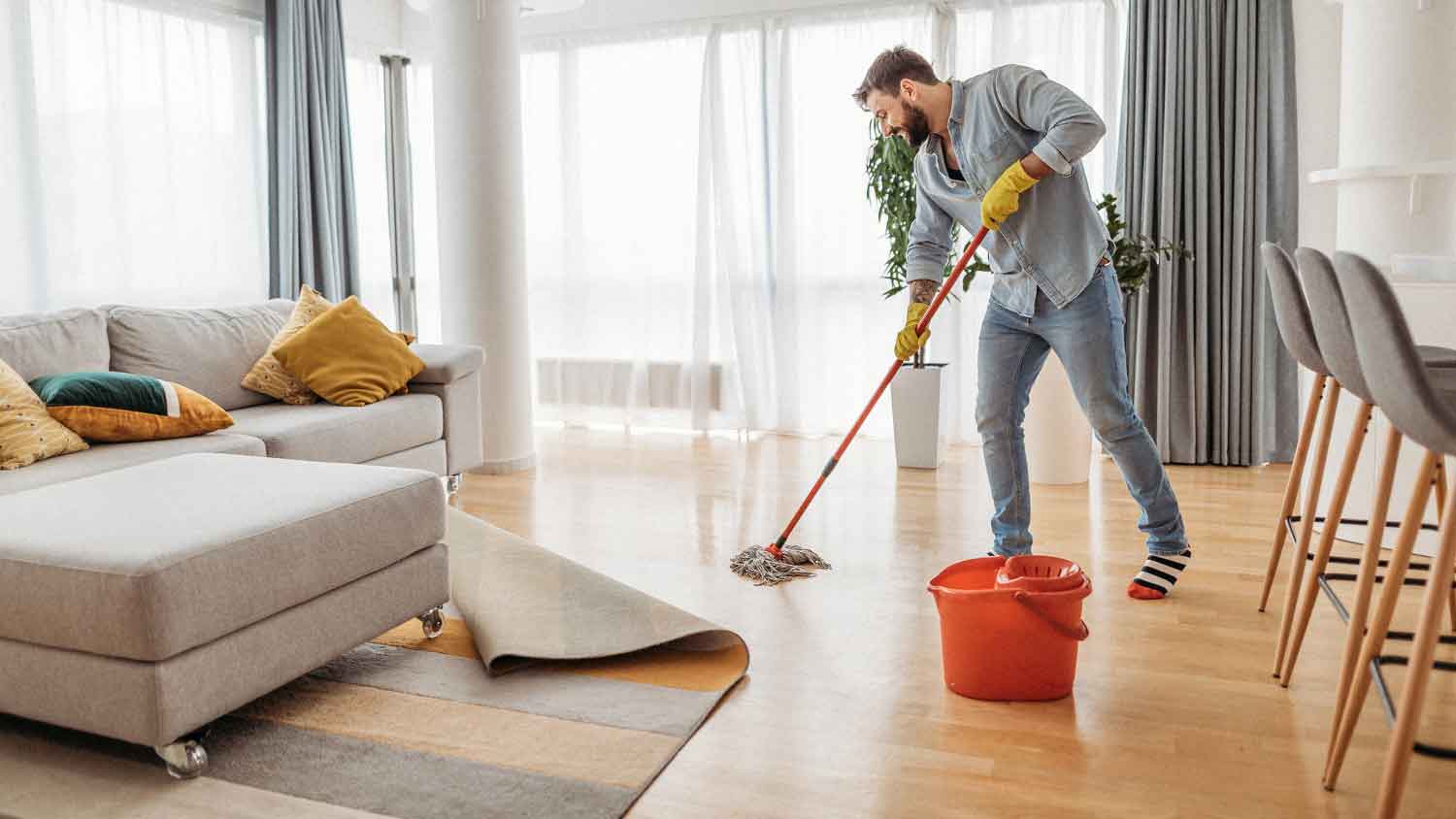
Discover how much move-out cleaning costs based on your home size, condition, the amount of belongings, and the services included.
Don’t get stuck with sticky spots that can damage the wood in your home


Wood flooring, furniture, and fixtures are some of the hardest working parts of our homes, but it can be difficult to keep them clean. Sticky residue on these surfaces from glue, stickers, or other types of adhesive can be more than annoying—it can damage the wood and lead to expensive refinishing costs. Use these simple methods to learn how to remove adhesive from wood surfaces for good.
Nobody likes to look at an old sticker stuck to the back of their kitchen table or feel a sticky spot on their bare feet when walking across a wood floor, but is it necessary to remove? It is if you want to preserve your wood and keep it from being damaged. Learning how to clean sticky floors, and other wood surfaces, can keep your wood in good condition and prevent unsightly residue marks that collect dust and dirt.
Adhesive can soften and pull up the finish on wood surfaces. The longer you leave it, the more likely it is that the sticky residue will bind to the finish, making it harder to remove without further damage or staining. To minimize damage, remove sticky residue from wood as soon as you notice it.
Before getting started, it’s a good idea to know what type of wood you’re dealing with, and how it’s finished. Some methods of removing sticky residue may damage the wood’s finish, so performing a patch test on an inconspicuous area can save you from any unpleasant surprises during the removal process.

Maybe your child put a sticker on your antique wooden table that just won’t budge no matter what you do. Sometimes a stubborn stain needs a firm hand. The following are stronger approaches to removing sticky residue—but they may damage wooden surfaces, including cabinets, hardwood floors, and tables. Proceed with caution.
Commercial adhesive-removal products are usually made of the same materials found below. If you choose to use one of these, make sure the product is safe for wood and follow the manufacturer’s instructions.
Use the small steam nozzle on a steamer or the low setting on a hair dryer or heat gun to loosen up the goo.
Use it for no more than 30 seconds at a time, and keep the heat source moving to avoid overheating the area.
Wipe or scrape it off with a soft rag or roll the sticky residue off using your fingers.
This tactic is one way to remove stickers from wood. You’ll need some sort of plastic scraper, like a credit card or the top of a plastic knife (the non-blade side), and an eraser to help you roll the adhesive away from the surface. Make sure the tool is firm enough to scrape up adhesive, but not sharp enough to damage the surface. If the wood is still sticky once the visible adhesive is removed, finish with one of the methods below.
Use your plastic scraper to gently scrape the sticker away from the wood surface. Keep in mind that repeated scraping can damage the finish, so proceed with caution. And even if the sticker is tough, don’t use a putty knife or metal blade.
Use a pencil eraser to wipe away the sticker adhesive. Simply erase over the areas that feel sticky, and the adhesive should roll off in clumps.
Clean the area by washing it with a mixture of hot water and a few drops of liquid dish detergent. You can use the rough side of the sponge to scrub away any remaining residue.
Dry the surface entirely after cleaning it with a dish towel. If there’s still sticky residue left behind, revert to one of the more aggressive methods listed below.
This method applies to WD-40, baby oil, vegetable oil, furniture polish, mineral oil, and really any oil-based substance. Before using any oil or polish, test it on an inconspicuous area. This method can soften or pull your finish or cause haloing and mooning, and it may prevent any future refinishing from sticking. This will also likely lift any wax surfacing from the floor.
Apply the oil to a soft cloth.
Scrub the sticky area. You may need to let the oil sit for up to two hours and/or apply heat using a hair dryer.
Clean the surface with a wood cleaner or a mild soap and water mixture.
Soak a cloth with vinegar or, for a gentler approach, use a solution of 1/2 cup of water and 2 teaspoons of white vinegar.
Wring the cloth out and wipe the wood surface.
Work slowly, giving the adhesive time to soften.
Roll the goo up with your fingers or scrape it off.
Clean the area with a wood cleaner.
Note that this method will strip away any wax.
Apply with a slightly dampened rag or a nonabrasive nylon cleaning pad with a fine surface.
Quickly rub it off.
Wipe the floor with a wood floor cleaner and damp rag.
This method may remove finish from the wood, so use caution or only use it on unfinished wood.
Apply a small amount to a cotton ball or swab.
Rub it gently over the residue in a circular motion, but don’t apply the solution beyond the residue.
Wipe with a dry cloth.
Wipe with a damp cloth.
Sometimes removing adhesive from wood isn’t a straightforward process. If you use an aggressive method on stubborn stickiness, you may end up with a dull spot or stain on the finish. In this case, you might have to touch up the finish or completely refinish the wood. To avoid damage and effectively solve the issue, try these tips:
Mind your chemical adhesive remover: Don’t use a chemical adhesive remover that can soften the finish. Use a gentle solution and read the manufacturer’s directions before applying.
Don’t use too much heat: You may want to use a blow dryer to soften glue before removing it, but it can cause the wood’s finish to bubble. Make sure you constantly move a blow dryer rather than concentrate the heat in one area, and ensure your finish can handle heat before you begin.
Peel the sticker or adhesive slowly: If you can peel up the sticky residue because it’s formed a film, peel slowly to avoid pulling up the finish.
Don’t use a metal blade as a scraper: A metal putty or butter knife can scratch the finish if you’re using it to scrape off sticky residue. Choose firm plastic tools that have a little bit of give in order to prevent damage.
Abrasive cleaning supplies like baking soda, steel wool, and nylon-coated sponges can permanently scratch surfaces. If you need a deep clean, a cleaning pro will have the right supplies to get your space sparkling and avoid damage.
Most homeowners can remove sticky residue on their own unless you’ve spilled a large amount of adhesive, the adhesive is particularly stubborn, or you’re working with a fragile antique or high-end piece. In this case, you may want to hire a local furniture cleaner or local house cleaning service. These types of pros will have solutions for the toughest sticky residue on the most fragile surfaces.
The cost of professional cleaning services is typically $30 to $50 per hour, but it can cost as much as $80 per hour for a specialized service in an area with a high cost of living. Most homeowners spend $100 to $250 on a cleaning service.
Raven and crew does absolutely fantastic job. They are very professional if any concerns were to occur with any of her work she always took responsibility and finished out with a great job. I have worked with her business for a year and have always been satisfied. Very trusted business and...
Window depot replaced all 14 windows in my house, front door and added a new back door. They did a wonderful job with some tricky windows in this old house. They were quick but efficient and cleaned up everything inside and out. I have already passed their contact information on to my...
Maple Tree Service should serve as a mentor for other business! Customer service was superior and beyond expectation. Response to request was prompt. The representative was very courteous and proud of the company. Quote was given during initial visit and work date established. A follow up...
I was contacted within a day of posting, met with Alfredo within days, who scheduled a cleaning next day. Gigi and a team member worked quickly and efficiently to give my home a thorough cleaning. I am recuperating from an extended illness and have been unable to keep up with my cleaning or...
his summer it was time... after building my home in 2010 I didn't think I would need to replace my windows for a while, but about 3/4 years after we moved in, our windows started fogging up. Our energy bills weren't too bad, however we knew our current windows were not efficient. So the...
They were on time. Did a thorough job everything was very clean. They did a the whole house INCLUDING APPLIANCES. Price was very reasonable.
We needed them to do extra work to remove existing wallpaper, and provide full primer and painting/trim work around existing furniture etc, during a move-in period. They did everything top-notch with minimal mess. They were always extremely on time, and very professional. They also cleaned...
They did a great job and were easy to work with. They thinned the trees out while leaving a pleasing shape and setting them up for the next several years. They cleaned everything up and couldn't have been nicer.
I found getting scheduled to be much easier than I had expected. I had company coming in town the following week and thought I would use that as an opportunity to have the house cleaned by a professional. Before purchasing this deal, I had read in some of the reviews about confusion from...
From average costs to expert advice, get all the answers you need to get your job done.

Discover how much move-out cleaning costs based on your home size, condition, the amount of belongings, and the services included.

Garage clean-out costs vary considerably depending on the garage size, the waste type and amount, and how much work you do yourself.

Tile and grout cleaning brings your tiled rooms back to life. In this guide, find out the details of how much it costs to hire tile and grout cleaners.

Looking for tips for microwave cleaning? We’ve assembled seven that’ll have your favorite kitchen shortcut looking (and smelling) as good as new in a flash.

Wondering, “Why is my floor dirty even after mopping?” Learn why this issue is happening, how to prevent it, and when to call a professional cleaner.

Mice can be a pain to get rid of, but even after they’re gone, their odor can linger. Here’s how to get rid of mice urine smell in your home.